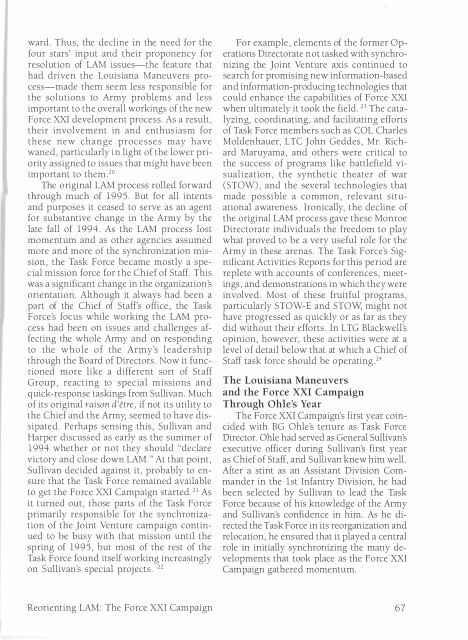The Modern Louisiana Maneuvers - US Army Center Of Military History
The Modern Louisiana Maneuvers - US Army Center Of Military History
The Modern Louisiana Maneuvers - US Army Center Of Military History
Create successful ePaper yourself
Turn your PDF publications into a flip-book with our unique Google optimized e-Paper software.
ward. Thus, the decline in the need for the<br />
four stars' input and their proponency for<br />
resolution of LAM issues-the feature that<br />
had driven the <strong>Louisiana</strong> <strong>Maneuvers</strong> process-made<br />
them seem less responsible for<br />
the solutions to <strong>Army</strong> problems and less<br />
important to the overall workings of the new<br />
Force XXI development process. As a result,<br />
their involvement in and enthusiasm for<br />
these new change processes may have<br />
waned, particularly in light of the lower priority<br />
assigned to issues that might have been<br />
important to them 20<br />
<strong>The</strong> original LAM process rolled forward<br />
through much of 1995. But for all intents<br />
and purposes it ceased to serve as an agent<br />
for substantive change in the <strong>Army</strong> by the<br />
late fall of 1994. As the LAM process lost<br />
momentum and as other agencies assumed<br />
more and more of the synchronization mission,<br />
the Task Force became mostly a special<br />
mission force for the Chief of Staff. This<br />
was a Significant change in the organization's<br />
orientation. Although it always had been a<br />
part of the Chief of Staff's office, the Task<br />
Force's focus while working the LAM process<br />
had been on issues and challenges affecting<br />
the whole <strong>Army</strong> and on responding<br />
to the whole of the <strong>Army</strong>'s leadership<br />
through the Board of Directors. Now it functioned<br />
more like a different sort of Staff<br />
Group, reacting to special missions and<br />
qUick-response taskings from Sullivan. Much<br />
of its original raison d'etre, if not its utility to<br />
the Chief and the <strong>Army</strong>, seemed to have dissipated.<br />
Perhaps sensing this, Sullivan and<br />
Harper discussed as early as the summer of<br />
1994 whether or not they should "declare<br />
victory and close down LAM." At that point,<br />
Sullivan decided against it, probably to ensure<br />
that the Task Force remained available<br />
to get the Force XXI Campaign started 21 As<br />
it turned out, those parts of the Task Force<br />
primarily responsible for the synchronization<br />
of the Joint Venture campaign continued<br />
to be busy with that mission until the<br />
spring of 1995, but most of the rest of the<br />
Task Force found itself working increasingly<br />
on Sullivan's special projects. 22<br />
Reorienting LAM: <strong>The</strong> Force XXI Campaign<br />
For example, elements of the former Operations<br />
Directorate not tasked with synchronizing<br />
the Joint Venture axis continued to<br />
search for promising new information-based<br />
and information-producing technologies that<br />
could enhance the capabilities of Force XXI<br />
when ultimately it took the field. 23 <strong>The</strong> catalyzing,<br />
coordinating, and facilitating efforts<br />
of Task Force members such as COL Charles<br />
Moldenhauer, LTC John Geddes, Mr. Richard<br />
Maruyama, and others were critical to<br />
the success of programs like battlefield visualization,<br />
the synthetic theater of war<br />
(STOW) , and the several technologies that<br />
made possible a common, relevant situational<br />
awareness. Ironically, the decline of<br />
the original LAM process gave these Monroe<br />
Directorate individuals the freedom to play<br />
what proved to be a very useful role for the<br />
<strong>Army</strong> in these arenas. <strong>The</strong> Task Force's Significant<br />
Activities Reports for this period are<br />
replete with accounts of conferences, meetings,<br />
and demonstrations in which they were<br />
involved. Most of these fruitful programs,<br />
particularly STOW-E and STOW, might not<br />
have progressed as qUickly or as far as they<br />
did without their efforts. In LTG Blackwell's<br />
opinion, however, these activities were at a<br />
level of detail below that at which a Chief of<br />
Staff task force should be operating. 24<br />
<strong>The</strong> <strong>Louisiana</strong> <strong>Maneuvers</strong><br />
and the Force XXI Campaign<br />
Through Ohle's Year<br />
<strong>The</strong> Force XXI Campaign's first year coincided<br />
with BG Ohle's tenure as Task Force<br />
Director. Ohle had served as General Sullivans<br />
executive officer during Sullivan's first year<br />
as Chief of Staff, and Sullivan knew him well.<br />
After a stint as an Assistant Division Commander<br />
in the 1st Infantry Division, he had<br />
been selected by Sullivan to lead the Task<br />
Force because of his knowledge of the <strong>Army</strong><br />
and Sullivan's confidence in him. As he directed<br />
the Task Force in its reorganization and<br />
relocation, he ensured that it played a central<br />
role in initially synchronizing the many developments<br />
that took place as the Force XXI<br />
Campaign gathered momentum.<br />
67
















